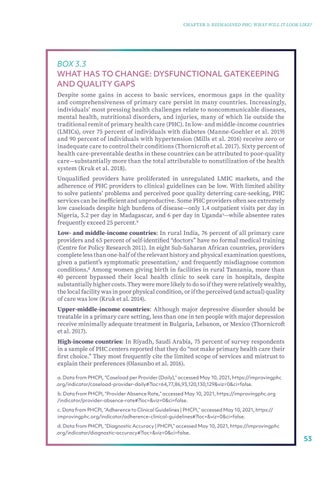CHAPTER 3: REIMAGINED PHC: WHAT WILL IT LOOK LIKE?
BOX 3.3 WHAT HAS TO CHANGE: DYSFUNCTIONAL GATEKEEPING AND QUALITY GAPS Despite some gains in access to basic services, enormous gaps in the quality and comprehensiveness of primary care persist in many countries. Increasingly, individuals’ most pressing health challenges relate to noncommunicable diseases, mental health, nutritional disorders, and injuries, many of which lie outside the traditional remit of primary health care (PHC). In low- and middle-income countries (LMICs), over 75 percent of individuals with diabetes (Manne-Goehler et al. 2019) and 90 percent of individuals with hypertension (Mills et al. 2016) receive zero or inadequate care to control their conditions (Thornicroft et al. 2017). Sixty percent of health care-preventable deaths in these countries can be attributed to poor-quality care—substantially more than the total attributable to nonutilization of the health system (Kruk et al. 2018). Unqualified providers have proliferated in unregulated LMIC markets, and the adherence of PHC providers to clinical guidelines can be low. With limited ability to solve patients’ problems and perceived poor quality deterring care-seeking, PHC services can be inefficient and unproductive. Some PHC providers often see extremely low caseloads despite high burdens of disease—only 1.4 outpatient visits per day in Nigeria, 5.2 per day in Madagascar, and 6 per day in Ugandaa—while absentee rates frequently exceed 25 percent.b Low- and middle-income countries: In rural India, 76 percent of all primary care providers and 65 percent of self-identified “doctors” have no formal medical training (Centre for Policy Research 2011). In eight Sub-Saharan African countries, providers complete less than one-half of the relevant history and physical examination questions, given a patient’s symptomatic presentation,c and frequently misdiagnose common conditions.d Among women giving birth in facilities in rural Tanzania, more than 40 percent bypassed their local health clinic to seek care in hospitals, despite substantially higher costs. They were more likely to do so if they were relatively wealthy, the local facility was in poor physical condition, or if the perceived (and actual) quality of care was low (Kruk et al. 2014). Upper-middle-income countries: Although major depressive disorder should be treatable in a primary care setting, less than one in ten people with major depression receive minimally adequate treatment in Bulgaria, Lebanon, or Mexico (Thornicroft et al. 2017). High-income countries: In Riyadh, Saudi Arabia, 75 percent of survey respondents in a sample of PHC centers reported that they do “not make primary health care their first choice.” They most frequently cite the limited scope of services and mistrust to explain their preferences (Olasunbo et al. 2016). a. Data from PHCPI, “Caseload per Provider (Daily),” accessed May 10, 2021, https://improvingphc .org/indicator/caseload-provider-daily#?loc=64,77,86,93,120,130,129&viz=0&ci=false. b. Data from PHCPI, “Provider Absence Rate,” accessed May 10, 2021, https://improvingphc.org /indicator/provider-absence-rate#?loc=&viz=0&ci=false. c. Data from PHCPI, “Adherence to Clinical Guidelines | PHCPI,” accessed May 10, 2021, https:// improvingphc.org/indicator/adherence-clinical-guidelines#?loc=&viz=0&ci=false. d. Data from PHCPI, “Diagnostic Accuracy | PHCPI,” accessed May 10, 2021, https://improvingphc .org/indicator/diagnostic-accuracy#?loc=&viz=0&ci=false.
53


